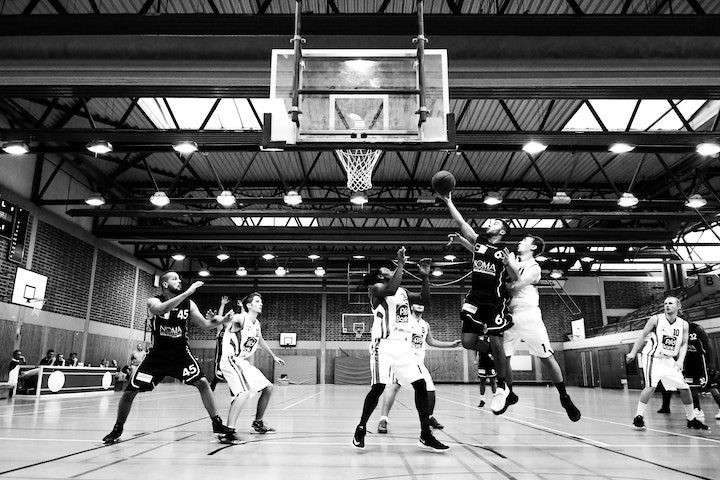Traveling in basketball is one of the most frequently misunderstood violations, leading to countless debates among players, coaches, and fans. Even seasoned basketball enthusiasts sometimes find themselves questioning whether a particular move constitutes a travel, especially with the nuances that exist across different levels of play. Moves like the euro step or step-through, while common in today’s game, often spark intense discussions about their legality.
If you’ve ever been confused about what traveling truly means in basketball, you’re not alone. Let’s clear up the confusion once and for all. This guide will break down the traveling rule in detail, providing a clear understanding of what constitutes a violation and how it’s enforced.
Defining Traveling in Basketball: The Basics
In its simplest form:
Traveling in basketball is a violation that occurs when a player moves their feet illegally while holding the ball.
Essentially, once a player gains control of the ball and stops dribbling, their movement is restricted. The fundamental rule is that a player cannot take more than two steps without dribbling the basketball. If a player takes more than two steps while maintaining possession without dribbling, it’s a traveling violation.
For a more detailed visual explanation of the FIBA traveling rules, which are largely consistent across most levels of basketball, consider watching instructional videos that break down the footwork and specific scenarios. These resources can be incredibly helpful in visualizing the rule in action.
Understanding the Pivot Foot in Basketball
The concept of the “pivot foot” is central to understanding the traveling rule. A player establishes a pivot foot when they receive the ball and come to a stop without dribbling. This pivot foot becomes the foot that must remain stationary on the court while the player is not dribbling.
Here’s a breakdown of pivot foot rules:
- Stationary Pivot: When a player is standing still upon receiving the ball, they can choose either foot as their pivot foot. Once established, this foot must stay planted.
- Moving Pivot: If a player is moving when they receive the ball, the first foot to touch the ground after catching the ball becomes the pivot foot.
- Pivoting Motion: Players are allowed to rotate or spin on their pivot foot. However, the pivot foot itself must maintain contact with the same spot on the floor; it cannot be dragged or slid.
- Lifting the Pivot Foot: A player can lift their pivot foot off the floor, but only under specific conditions. The ball must leave their hand to start a dribble, pass, or shot before the pivot foot returns to the ground. If the pivot foot touches the floor again before the ball is released, it’s a traveling violation.
Why is the Traveling Rule Necessary in Basketball?
The traveling rule might seem restrictive, but it’s a crucial element of basketball designed to maintain a balance between offense and defense.
The primary reason for the traveling rule is to prevent the offensive team from having an unfair advantage and to give the defense a fair opportunity to contest.
Imagine a game without a traveling rule. Offensive players could simply run or sprint with the ball without dribbling, making it virtually impossible for defenders to stop them. They could take unlimited steps, change direction at will, and essentially move across the court unimpeded. Defense would become futile, and the game would lose its competitive balance and strategic depth.
To prevent such a scenario and ensure fair play, basketball incorporates rules like the traveling violation, along with others such as the double dribble and backcourt violations. These rules collectively ensure that offensive advantages are earned through skill and strategy, not simply through unrestricted movement.
 pivot-foot-traveling-basketball
pivot-foot-traveling-basketball
Penalty for a Traveling Violation
Similar to a double dribble or other ball-handling violations, a traveling call results in a turnover. This means possession of the ball is awarded to the opposing team.
- Lower Levels (College and Below): In most levels of basketball below the NBA, after a traveling violation, the defensive team is given the ball out of bounds at the sideline or baseline, at the point closest to where the violation occurred.
- NBA: In the NBA, the rule is slightly different. The ball must be inbounded by the defensive team between the free-throw line extended and the baseline, providing some variation in where the play restarts.
Common Examples of Traveling Violations
While taking more than two steps and incorrectly using the pivot foot are the most common forms of traveling, there are several other scenarios that constitute a traveling violation:
- Rolling on the Floor: If a player falls to the ground while holding the basketball and then rolls over, it’s a travel. The player is expected to attempt to get up while dribbling or pass the ball.
- Jumping While in Possession (“Up and Down”): If a player jumps into the air while holding the ball, they must shoot or pass the ball before either foot returns to the ground. Landing with the ball without releasing it is traveling.
- Passing to Oneself: Intentionally or accidentally throwing the ball in the air and catching it again without it being touched by another player is a traveling violation. This is distinct from a legitimate self-pass to initiate a dribble.
- Falling Down: If a player falls to the floor while holding the ball without being fouled, and their pivot foot moves as a result of the fall, it will be called a travel.
- Sliding or Dragging the Pivot Foot: The pivot foot must remain anchored in its initial spot. Sliding, dragging, or hopping with the pivot foot while not dribbling is illegal, even if the foot technically stays in contact with the floor.
- Stepping Before Dribbling: One of the most frequently called traveling violations, especially at lower levels. A player must begin dribbling before their pivot foot leaves the ground on their first step. Taking a step and then starting the dribble is traveling.
- Attempting to Get Up Without Dribbling: If a player is on the floor with the ball, they cannot stand up while still holding the ball unless they are actively dribbling. Standing up with the ball without dribbling is traveling.
- Shuffling of the Feet: Especially common among younger or less experienced players, shuffling involves inadvertently moving both feet without dribbling, often when trying to create space or pass. This movement of the pivot foot constitutes a travel.
How Strictly Are Traveling Rules Enforced?
The enforcement of traveling rules can vary depending on the level of play and the referee’s interpretation. Basketball is a fast-paced game, and it’s challenging for referees to catch every single infraction in real time.
-
NBA Level: Critics sometimes argue that traveling is not called as frequently in the NBA as it should be. However, it’s important to note that the NBA’s interpretation of the traveling rule, particularly concerning the “gather step,” is slightly different and more lenient than in other levels. The NBA rulebook dedicates eight sections to defining traveling, incorporating nuances like the gather step, which allows players a bit more freedom in their initial movement after picking up their dribble. Even with these nuances, missed calls do happen due to the speed of the game.
-
Youth Basketball: At the youth level, referees often exercise more leniency with traveling calls. If every technical traveling violation were called, especially with beginners, the game could become bogged down with whistles, disrupting the flow and enjoyment. However, it’s also crucial that referees don’t ignore blatant travels, as this can hinder player development and understanding of the rules. The goal is to find a balance, allowing young players to develop while still learning the fundamentals of legal footwork. As players progress to higher levels, the officiating becomes stricter.
Coaching Players to Avoid Traveling
Teaching players, especially young athletes, how to avoid traveling is a fundamental aspect of basketball coaching. It requires patience and consistent reinforcement.
Common traveling mistakes among beginners include:
- Running with the ball without dribbling.
- Accidentally changing or dragging their pivot foot.
- Shuffling their feet when trying to pass or move.
Strategies for coaches to help players avoid traveling:
- Clear Explanation: Start by clearly explaining what traveling is, demonstrating proper footwork, and emphasizing the importance of the pivot foot.
- Practice Drills: Incorporate drills that specifically focus on dribbling, jump stops, and pivot footwork. These drills should be a regular part of practice sessions to build muscle memory and correct habits.
- Immediate Correction: During practices and games, when a player commits a traveling violation, stop the play and immediately explain the mistake. Show them the correct footwork and explain how to avoid the travel in the future. This immediate feedback is crucial for learning.
- Positive Reinforcement: While correction is necessary, also provide positive reinforcement when players demonstrate correct footwork and avoid traveling. This encourages them to continue practicing and implementing the right techniques.
- Gradual Progression: Start with basic drills and gradually increase the complexity as players improve their understanding and skills.
Initially, there will likely be frequent stoppages during practice as players learn, but this is a necessary part of the learning process. Consistent coaching and practice will help players develop the correct footwork and significantly reduce traveling violations.
Conclusion
Traveling in basketball, while sometimes debated, is a clearly defined violation related to illegal foot movement while in possession of the ball. It’s designed to ensure fair play and prevent the offense from gaining an insurmountable advantage.
Whether it’s taking too many steps, misusing the pivot foot, or one of the other specific examples, traveling violations are a regular part of basketball at all levels. Coaches play a vital role in teaching players proper footwork to minimize these violations.
By understanding the rules and practicing correct techniques, players can avoid traveling, maintain possession, and contribute more effectively to their team’s offense. Mastering the footwork to avoid traveling is a fundamental skill that enhances a player’s overall basketball proficiency.
Further Reading: Basketball Rules and Regulations (Updated Version)

